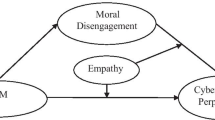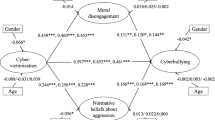Abstract
The purpose of the study was to examine the association between affective empathy, cognitive empathy, and gender on cyberbullying among adolescents. Participants were 396 adolescents from Singapore with age ranging from 12 to 18 years. Adolescents responded to a survey with scales measuring both affective and cognitive empathy, and cyberbullying behavior. A three-step hierarchical multiple regression analysis was used with cyberbullying scores as the dependent variable. Gender was dummy coded and both affective and cognitive empathy were centered using the sample mean prior to creating interaction terms and entering them into the regression equations. The testing, probing and interpretation of interaction effects followed established statistical procedures. Results from hierarchical multiple regression analysis indicated a significant three-way interaction. At low affective empathy, both boys and girls who also had low cognitive empathy had higher scores on cyberbullying than those who had high cognitive empathy. This pattern of results was similarly found for boys at high affective empathy. However, for girls, high or low levels of cognitive empathy resulted in similar levels of cyberbullying. Implications of these findings include the need for empathy training and the importance of positive caregiver-child relationships in reducing cyberbullying behavior among adolescents.

Similar content being viewed by others
References
Patchin JW, Hinduja S (2006) Bullies move beyond the schoolyard: a preliminary look at cyberbullying. Youth Violence Juv Justice 4:148–169
Kowalski RM, Limber SP (2007) Electronic bullying among middle school students. J Adolesc Health 41:S22–S30
Raskauskas J, Stoltz AD (2007) Involvement in traditional and electronic bullying among adolescents. Dev Psychol 43:564–575
Arnett JJ (2008) The neglected 95%: why American psychology needs to become less American. Am Psychol 63:602–614
Mehrabian A, Epstein N (1972) A measure of emotional empathy. J Pers 40:525–543
Hogan R (1969) Development of an empathy scale. J Consult Clin Psychol 33:307–316
Cohen D, Strayer J (1996) Empathy in conduct-disordered and comparison youth. Dev Psychol 32:988–998
Miller PA, Eisenberg N (1988) The relation of empathy to aggressive and externalizing/antisocial behavior. Psychol Bull 103:324–344
Eisenberg N, Fabes F (1998) Prosocial development. In: Damon W, Eisenberg N (eds) Handbook of child psychology: vol. 3. Social, emotional and personality development, 5th edn. Wiley, New York, pp 701–778
Frick PJ, Cornell AH, Bodin SD, Dane HE, Barry CT, Loney BR (2003) Callous–unemotional traits and developmental pathways to severe conduct problems. Dev Psychol 39:246–260
Hinduja S, Patchin JW (2008) Cyberbullying: an exploratory analysis of factors related to offending and victimization. Deviant Behav 29:129–156
Jolliffe D, Farrington DP (2006) Examining the relationship between low empathy and bullying. Aggress Behav 32:540–550
Feshbach ND (1987) Parental empathy and child adjustment/maladjustment. In: Eisenberg N, Strayer J (eds) Empathy and its development. Cambridge University Press, New York, pp 271–291
Shechtman Z (2002) Cognitive and affective empathy in aggressive boys: implications for counseling. Int J Adv Couns 24:211–222
Crick N (1995) Relational aggression: the role of intent attributions, feelings of distress, and provocation type. Dev Psychopathol 7:313–322
Loudin JL, Loukas A, Robinson S (2003) Relational aggression in college students: examining the roles of social anxiety and empathy. Aggress Behav 29:430–439
Smith PK, Mahdavi J, Carvalho M et al (2008) Cyberbullying: its nature and impact in secondary school pupils. J Child Psychol Psychiatry 49:376–385
Li Q (2006) Cyberbullying in schools: a research of gender differences. Sch Psychol Int 27:157–170
Ybarra ML, Mitchell KJ (2004) Youth engaging in online harassment: associations with caregiver-child relationships, Internet use, and personal characteristics. J Adolesc 27:319–336
Lennon R, Eisenberg N (1987) Gender and age differences in empathy and sympathy. In: Eisenberg N, Strayer J (eds) Empathy and its development. Cambridge University Press, New York, pp 195–218
Jolliffe D, Farrington DP (2006) Development and validation of the basic empathy scale. J Adolesc 29:589–611
Joinsen AN (1998) Causes and implications of disinhibited behavior on the Internet. In: Gackenbach J (ed) Psychology and the Internet: intrapersonal, interpersonal and transpersonal implications. Academic Press, New York, pp 43–60
Kiesler S, Siegel J, McGuire TW (1984) Social psychological aspects of computer mediated communications. Am Psychol 39:1123–1134
Kohlberg L (1984) The psychology of moral development. Jossey Bass, San Francisco
Silfver M, Helkama K (2007) Empathy, guilt, and gender: a comparison of two measures of guilt. Scand J Psychol 48:239–246
Eisenberg N, Zhou Q, Koller S (2001) Brazilian adolescents’ prosocial moral judgment and behavior: relations to sympathy, perspective taking, gender role orientation, and demographic characteristics. Child Dev 72:518–534
Byrne BM (2006) Structural equation modeling with EQS: basic concepts, applications and programming, 2nd edn. Lawrence Erlbaum, Mahwah
Bentler PM (2005) EQS 6 structural equations program manual. Multivariate Software, Encino
Satorra A, Bentler PM (1988) Scaling corrections for chi-square statistics in covariance structure analysis. ASA 1988 Proceedings of the Business and Economic Section. American Statistical Association, Alexandria, VA, pp 308–313
Curran PJ, West SG, Finch JF (1996) The robustness of test statistics to nonnormality and specification error in confirmatory factor analysis. Psychol Methods 1:16–29
Satorra A, Bentler PM (2001) A scaled difference chi-square test statistic for moment structure analysis. Psychometrika 66:507–514
Aiken LS, West SG (eds) (1991) Multiple regression: testing and interpreting interactions. Sage Publications, Thousand Oaks
Postmers T, Spears R (1998) Deindividuation and anti-normative behavior: a meta-analysis. Psychol Bull 123:238–259
Bjorkqvist K, Osterman K, Kaukiainen A (2000) Social intelligence–empathy = aggression? Aggress Violent Behav 5:191–200
Derzon JH, Wilson SJ, Cunningham CA (1999) The effectiveness of school-based interventions for preventing and reducing violence. Vanderbilt Institute of Public Policy Studies, Nashville
Ttofi MM, Farrington DP, Baldry AC (2008) Effectiveness of programs to reduce school bullying: a systematic review. Swedish Council of Crime Prevention, Stockholm
Chibbaro JS (2007) School counselors and the cyberbully: interventions and implications. Prof Sch Couns 11:65–67
Greenberg MT, Speltz ML, DeKlyen M (1993) The role of attachment in the early development of disruptive behavior problems. Dev Psychopathol 5:191–213
Ang RP (2005) Development and validation of the teacher-student relationship inventory using exploratory and confirmatory factor analysis. J Exp Educ 74:55–73
Hughes JN, Cavell TA, Jackson T (1999) Influence of the teacher-student relationship on childhood conduct problems: a prospective study. J Clin Child Psychol 28:173–184
Ooi YP, Ang RP, Fung DSS et al (2006) The impact of parent–child attachment on aggression, social stress, and self-esteem. Sch Psychol Int 27:552–566
Acknowledgments
The authors would like to thank Vania Yip for her assistance with this project. This research was supported by an Academic Research Fund Tier 1 grant [RG96/07] awarded to the first author.
Author information
Authors and Affiliations
Corresponding author
Rights and permissions
About this article
Cite this article
Ang, R.P., Goh, D.H. Cyberbullying Among Adolescents: The Role of Affective and Cognitive Empathy, and Gender. Child Psychiatry Hum Dev 41, 387–397 (2010). https://doi.org/10.1007/s10578-010-0176-3
Published:
Issue Date:
DOI: https://doi.org/10.1007/s10578-010-0176-3




